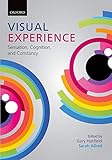Visual experience [Texte imprimé] : sensation, cognition, and constancy / edited by Gary Hatfield, Sarah Allred
نوع المادة : نصتفاصيل النشر:Oxford : Oxford University Press, 2012وصف:1 vol. (X-253 p) : couv ill., graph. ; 24 cmتدمك:
نصتفاصيل النشر:Oxford : Oxford University Press, 2012وصف:1 vol. (X-253 p) : couv ill., graph. ; 24 cmتدمك:- 978-0-19-959727-7
- 152.14 23E
- 152
| نوع المادة | المكتبة الحالية | المجموعة | رقم الطلب | رقم النسخة | حالة | تاريخ الإستحقاق | الباركود | |
|---|---|---|---|---|---|---|---|---|
|
|
Bibliothèque centrale En accès libre | Collection générale | 152 / 1 (إستعراض الرف(يفتح أدناه)) | 1 | المتاح | 000005352838 |
"This volume arises from a research workshop on Cognitive and Developmental Factors in Perceptual Constancy, held at the Institute for Research in Cognitive Science (IRCS) of the University of Pennsylvania in February, 2009. We asked the invited participants - chosen to include psychologists and philosophers, established scholars as well as new faces - to examine whether and how we can tease apart cognitive and phenomenal factors in people's responses to size (or other spatial properties) and color"--Preface
Notes bibliogr.
"'Seeing' happens effortlessly and yet is endlessly complex. One of the most fascinating aspects of visual perception is its stability and constancy. As we shift our gaze or move about the world, the light projected onto the retinas is constantly changing . Yet the surrounding objects appear stable in their properties. Psychologists have long been interested in constancies, exploring questions such as: How good is constancy? Is constancy a fact about how things look, or is it a product of our beliefs and judgments about how things look? How can the contents of visual experience be studied experimentally? Philosophers have also long been interested in characterizing visual experience, but have only recently become widely interested in the constancies. As psychologists and philosophers have interacted, new questions have arisen: If experience is not fundamentally of the retinal image, but does not always exhibit constancy, how should this intermediate state be described? Is a new taxonomy needed to classify the several types of visual experience elicited by the same object? Should we regard any departure from constancy as a failure of the visual system, or might such a departure be a reasonable or adaptive response? How do seeing and believing interact to yield our visual experience? 'Visual Experiences' explores size constancy and color constancy. It considers methodologies for studying conscious visual perception, efforts to describe visual experience in relation to constancy, what it means that constancy is not always perfect, and the conceptual resources needed for explaining visual experience. This interdisciplinary book is a valuable resource for both vision scientists and philosophers of mind"--Publisher's description, p. [4] of cover
لا توجد تعليقات على هذا العنوان.


